There’s so much more to breads in Indian cuisine, than just the well-known flatbreads. For instance, take this Pav, which is also popular under the sobriquet Ladi Pav and is a specialty from the ‘city of dreams,’ Mumbai in Maharashtra. While there’s more to read about this Mumbai style bun in the post, I’m also sharing a step-by-step Pav Recipe for you to easily follow and make this soft, fluffy and light bread at home. The ingredients are not much but the procedure is quite long. So, make sure to follow the recipe well to get the best result.
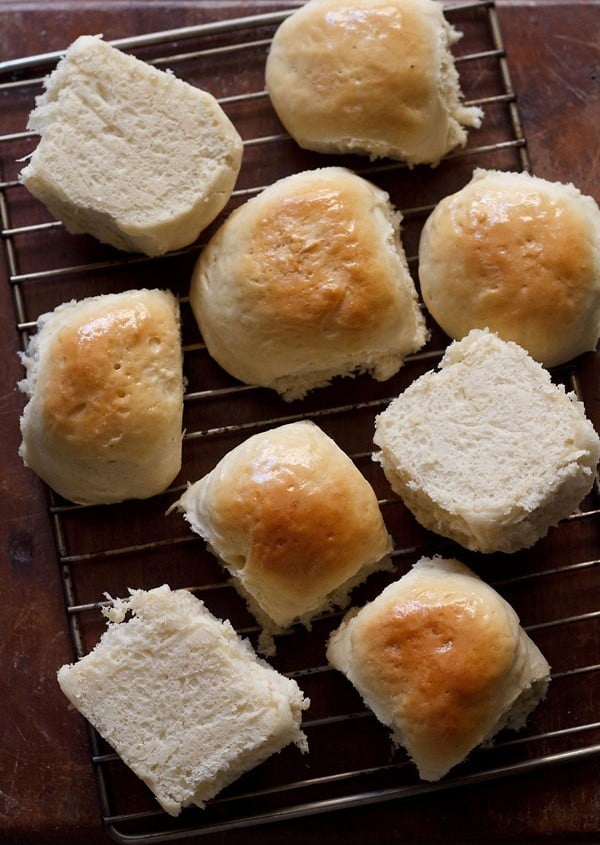
About Pav Recipe
Pav is basically a small loaf of bread, introduced by the Portuguese in India. Thus, also referred to as ‘pao,’ going by the Portuguese food traditions.
In Hindi, the word Pav refers to ‘quarter or ¼ᵗʰ .’ Sometimes you get the Ladi Pav in a set of 4. It is also said that since the bakers kneaded the dough with their feet at that time, the name is Pav which means ‘feet’ in Hindi.
Commercially, Pav is always made with maida or all-purpose flour. However, at home, we can make these small bread rolls with whole wheat flour (atta) or other flours. I also make a Pav Recipe with 100% whole wheat flour.
You could opt to make Pav with equal portions of both all-purpose flour and whole wheat flour. Pav made this way using an equal mix of both the flours also yields a soft and light texture.
The recipe of Mumbai Ladi Pav in this post is made with 100% all-purpose flour (maida). I make these light bread rolls once in a while or on demand, when the regular Whole Wheat Bread or chapatis get monotonous for the family.
I have developed this Pav Recipe over a period of time to get the best result. The recipe method makes use of the sponge or ‘poolish’ method for leavening, resulting in super soft and spongy Pav.
I have added instant yeast in the recipe. However, fresh yeast or dry active yeast can also be used. To get the aroma and taste like that of the Ladi Pav made in the bakeries, it is advisable to use fresh yeast. The proportions of all 3 are mentioned in the recipe card below.
Usually, I make these Mumbai style buns or dinner rolls to be served with Pav Bhaji, Misal Pav, Masala Pav, Vada Pav, samosa pav or pav sandwich. I never buy Pav from outside as this recipe really yields in excellent homemade bread rolls.
How to make Pav
Make Dough
1. In a bowl take, 1 cup all-purpose flour, 1 teaspoon instant yeast (rapid rise yeast) and 2 teaspoons sugar.
Make sure the water is lukewarm. If not then all your efforts will go waste. The water should not be hot.
Note: If using active dry yeast or fresh yeast, then ensure the water is neither hot nor cool. Hot water will destroy the yeast and less warm water or cool water won’t help in activating the yeast.
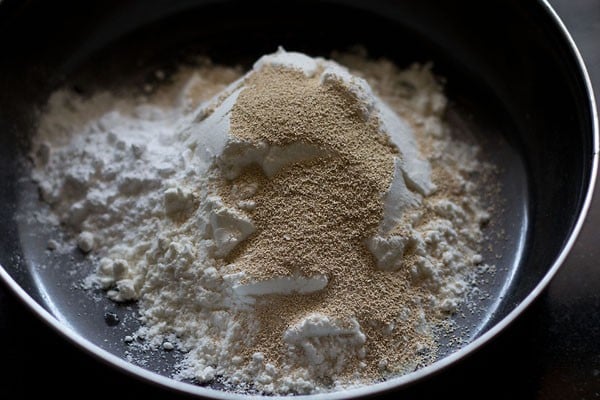
2. Add 1 cup lukewarm water.
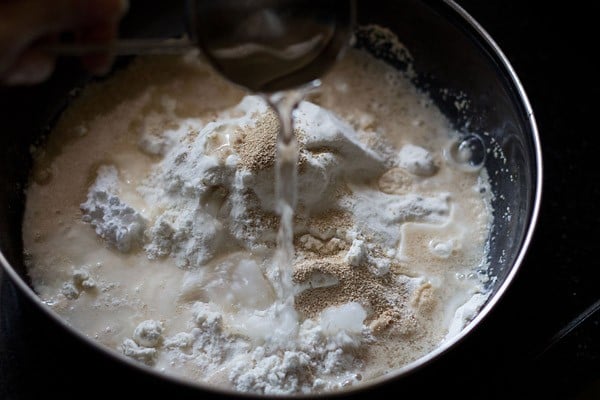
3. Stir or whisk to make a smooth and thick batter without any lumps.
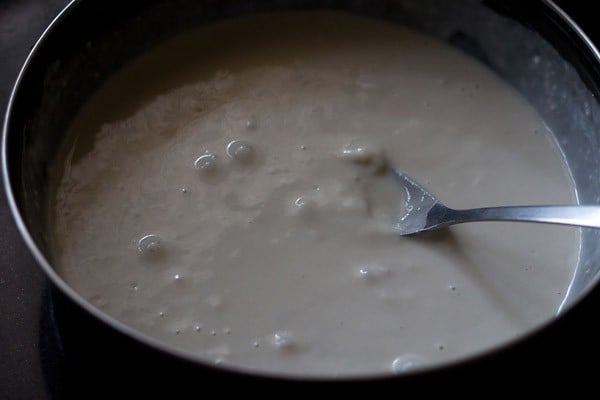
4. Cover and keep the bowl for 30 to 40 minutes or till you see a bubbly and frothy mixture. The batter would also have risen.
The picture below shows the consistency. This is the sponge starter.
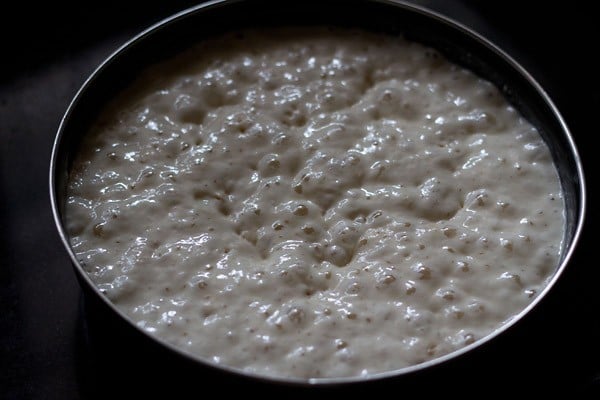
5. Add 2 tablespoons oil, 1 teaspoon salt and 1 cup all-purpose flour.
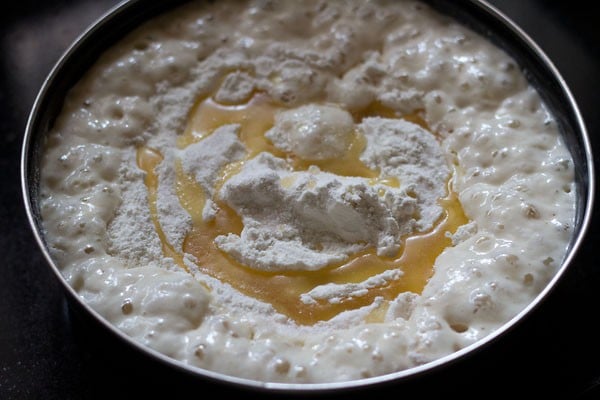
6. Mix with a spoon or spatula.
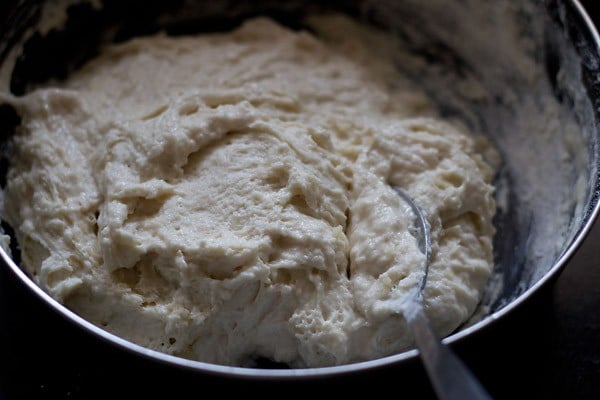
7. Add 1.25 cups of all-purpose flour.
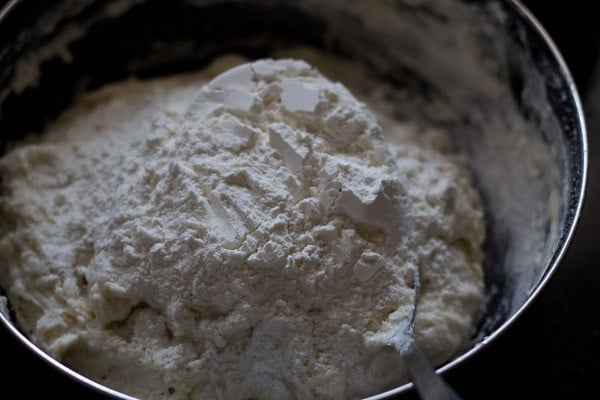
8. Mix and then begin to knead for about 10 to 12 minutes. If the dough appears sticky, then you can add about ¼ to ½ cup flour.
The proportion of water to be added depends on the quality of the flour. Overall, I added 3.25 cups flour and 1 cup water.
You can also knead the dough using a stand-mixer bowl attached to a dough hook.
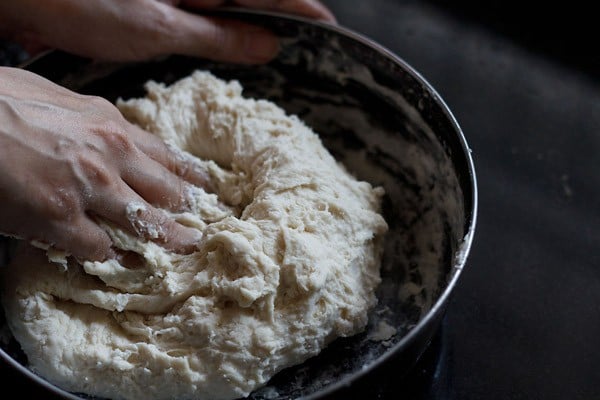
9. Knead to a smooth, pliable, soft and elastic dough. The dough on stretching should not break or tear.
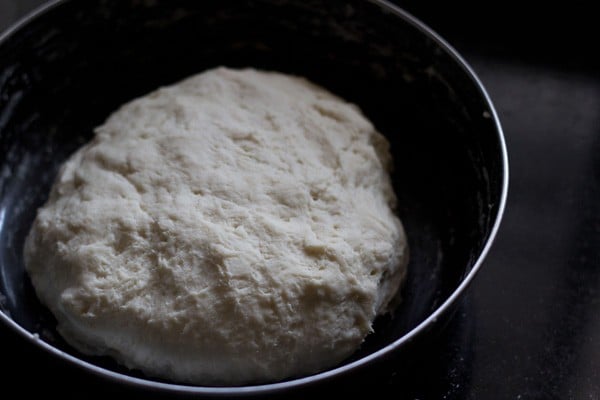
Leaven Dough
10. Spread oil or butter all over the dough. Cover the bowl with a kitchen cotton napkin or a lid and keep the bread to leaven for 20 to 25 minutes.
The leavening time depends on the type of yeast used and the temperature conditions.
- For instant yeast, 20 to 25 minutes of the first rise is enough.
- For dry active yeast or fresh yeast, you will have to keep for about 45 minutes to 1 hour or more.
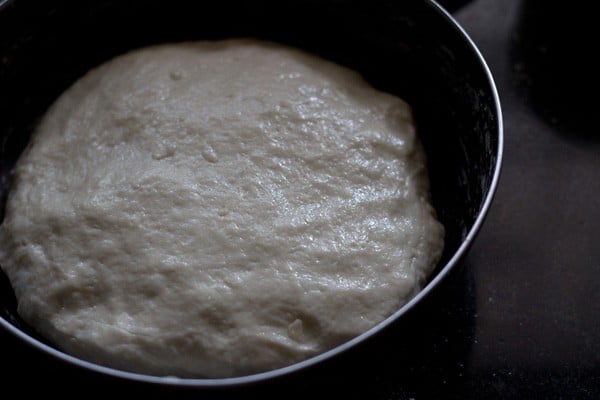
11. The risen and doubled dough for Pav.
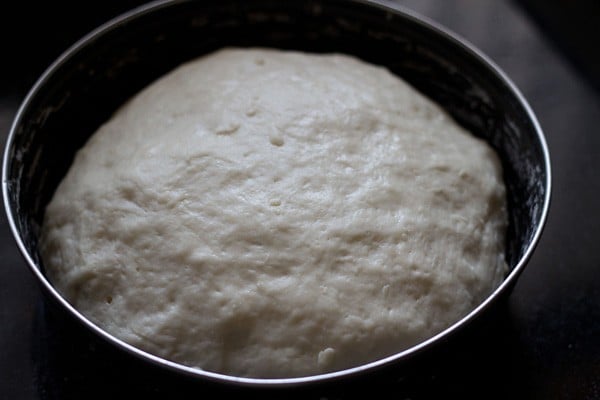
12. Gently punch and deflate the dough and form a log.
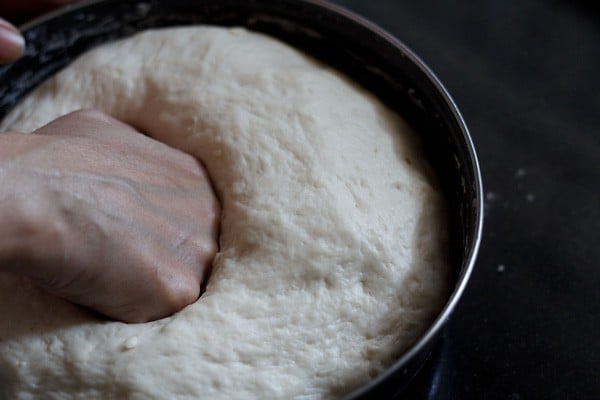
13. Slice the log into equal portions.
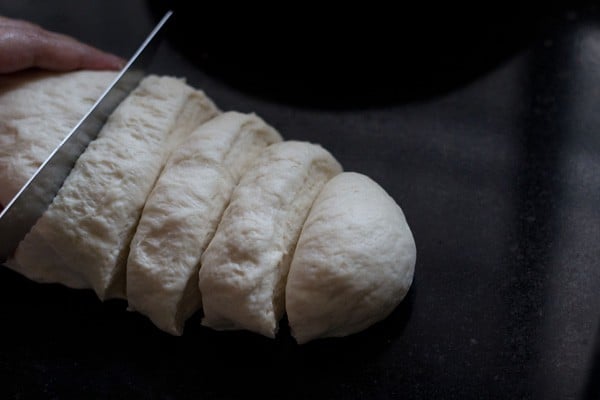
14. Take each portion and roll between your palms to get a smooth round roll.
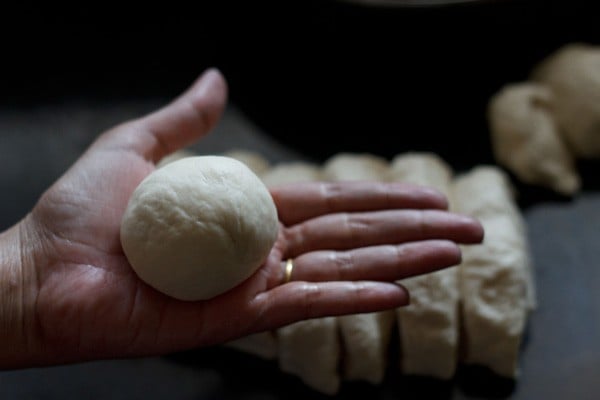
Bake Pav
15. Make rolls this way and place them in a greased baking tray keeping 1 inch space between each. Cover and keep for 25 to 30 minutes for the second rise. The small buns would increase in size.
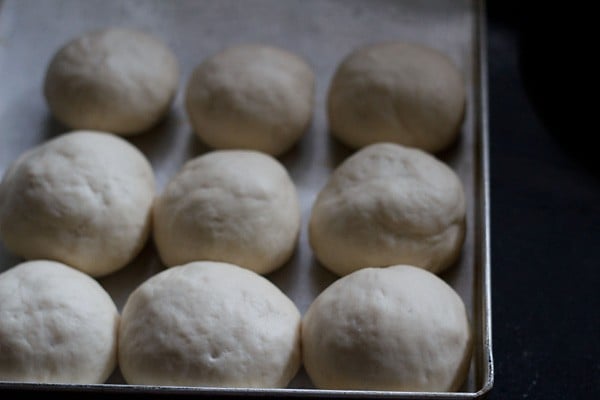
16. Then, brush the rolls with some milk. This gives a golden color to the Ladi Pav.
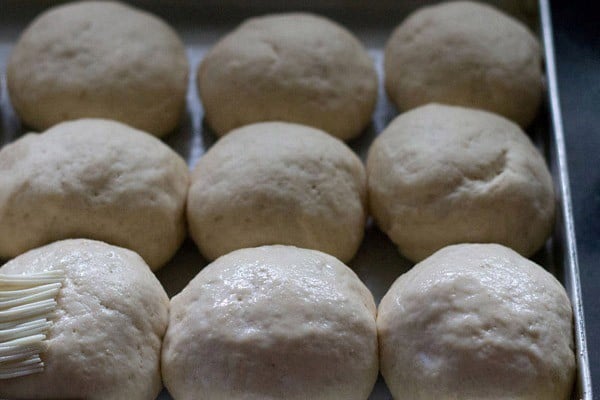
17. Place the baking tray in a preheated oven at 200° C/ 390° F for 25 to 30 minutes or till the tops turn golden and the rolls sound hollow on tapping.
Before baking, remember to preheat oven at for 200° C/ 390° F 15 minutes.
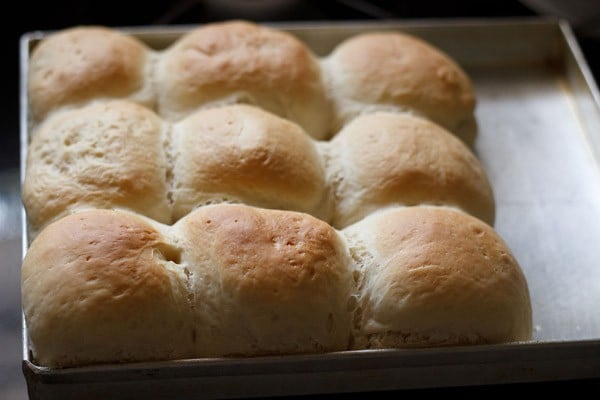
18. Remove the baked rolls from the tray (with a spatula) and place on a wired rack or wired tray, so that they don’t become softened and moist from the bottom due to heat condensation.
Brush melted butter or spread softened butter on top of the Pav for a glaze. This is an optional step.
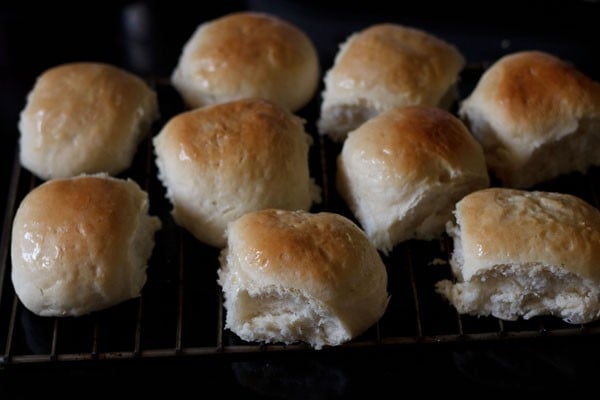
19. Serve Pav warm or at room temperature with any curry like Usal, a vegetable dish or just as plain Maska Pav (buttered rolls) with Masala Chai or Cutting Chai.
You can also use them to make Mumbai street food snacks like pav bhaji, misal pav, vada pav or Kacchi Dabeli.
Leftover Pav keeps well for about a week in the fridge and a few weeks in the freezer.
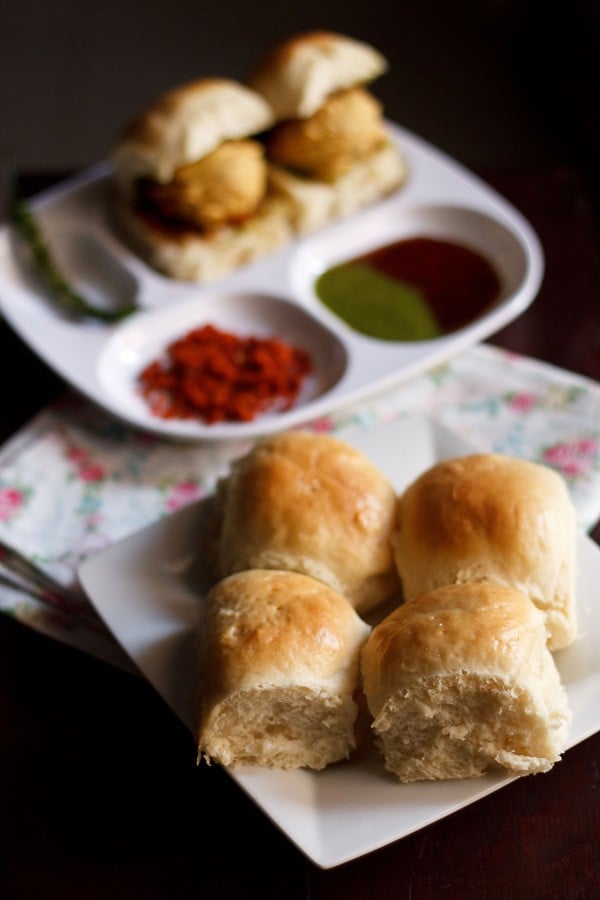
Expert Tips
- If you can source, then try making pav with unbleached all-purpose flour. You can also make these fluffy dinner rolls with bread flour.
- The quantity of water to be added depends on the quality of flour. If the dough become sticky, then add some flour and if the dough looks dry, then add some water.
- Instead of kneading with hands, you can also knead the dough in a food processor or in an electric mixer with a dough hook.
- If the top surface of the buns browns quickly, then place aluminium foil or parchment paper on the top. This will avoid further browning.
- The leavening time depends on the type of yeast used and the temperature conditions. For instant and fresh yeast, keep for 20 to 25 minutes for the first rise. For dry active yeast, you will have to keep for about 45 minutes to 1 hour or more.
- Brushing the pav bread rolls with some milk gives a nice golden color to them on baking. You can brush the baked buns with melted butter too for a glaze.
- Once the Ladi Pav bread is baked, remove them from the tray and place on a wired rack so that they don’t soften or moisten from the bottom due to heat condensation.
More Bread Recipes To Try!
Bread Recipes
Bread Recipes
Bread Recipes
Bread Recipes
Please be sure to rate the recipe in the recipe card or leave a comment below if you have made it. For more vegetarian inspirations, Sign Up for my emails or follow me on Instagram, Youtube, Facebook, Pinterest or Twitter.
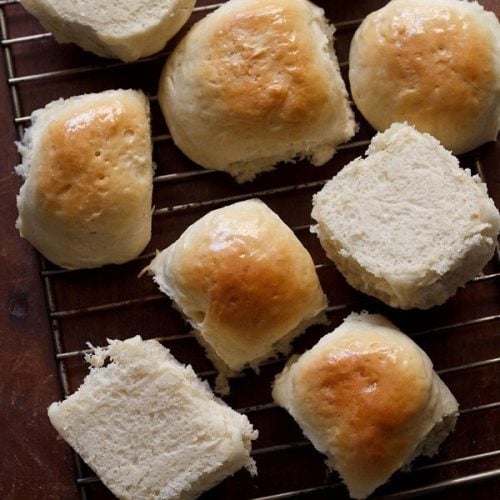
Pav Recipe | Ladi Pav | Pav Bread
Ingredients
- 3.25 to 3.5 cups all-purpose flour (maida) – I added 3.25 cups flour
- 2 tablespoons oil or softened butter, use any neutral flavored oil
- 1 teaspoon instant yeast or 1.5 teaspoon dry active yeast or 1 tablespoon fresh yeast
- 2 teaspoons sugar
- 1 teaspoon salt or add as required
- 1 cup water – lukewarm, do add water if needed later
- 1 to 2 tablespoons milk – for brushing, optional
- 1 to 2 tablespoons butter – melted, for brushing on pav bread
Instructions
Making dough
- In a bowl take 1 cup of all-purpose flour, instant yeast and sugar.
- Add 1 cup lukewarm water. Stir or whisk to make a smooth thick batter without any lumps.
- Cover and keep the bowl for 30 to 40 minutes till you see a bubbly and frothy layer on the top. The batter would also have risen.
- Add oil, salt and 1 cup flour. Mix with a spoon or spatula.
- Next add 1.25 cup flour. Mix again and then begin to knead for about 10 to 12 minutes.
- If the dough appears sticky then you can about ¼ cup flour more or as needed. The proportion of water to be added, depends on the quality of the flour. I added 3.25 cups flour for 1 cup of lukewarm water.
- Knead very well to a smooth, soft, supple and elastic dough.
- Place dough in a bowl. Spread oil or softened butter all over the dough.
Leavening pav dough
- Cover the bowl with a lid or a kitchen cotton napkin and keep the bread to leaven for 20 to 25 minutes.
- Once the pav dough has risen and doubled, then gently punch and deflate the dough and form a neat log.
- Cut the log into equal sizes. Take each portion and roll between your palms to get a smooth round roll.
- Make rolls this way and place them in a greased tray keeping 1 inch space between all of them.
- Cover and allow the second rise for 25 to 30 minutes. The small buns would increase in size.
Baking ladi pav
- Just before 15 minutes you bake the pav, preheat the oven at 200° C/ 390° F.For a regular oven, heat both the top and bottom elements. For a microwave oven with convection mode, preheat for 15 minutes at 180° C/356° F.
- Then brush the pav buns with some milk. This gives a golden color to laadi pav.
- Place the baking tray in the center rack in a preheated oven at 200° C/ 390° F for 25 to 30 mins or till the tops turn golden and the pavs sound hollow on tapping. For baking in the microwave oven at convection mode, bake at 180° C/356° F.
- Remove them from the tray (with a spatula) and place on a wired rack or wired tray, so that they don't become softened and moist from the bottom due to heat condensation.
- Brush melted butter or spread softened butter on top of the pavs. This is an optional step.
- Serve the Pav warm or at room temperature with any curry, vegetable dish or just as plain bun maska pav (buttered rolls) served with masala chai.
- Pav can be stored in the refrigerator for about a week. Keep them in air-tight a container or a bread box.
Notes
- If the dough become sticky then add some flour and if the dough looks dry, then add some water.
- If the top surface of the bread browns quickly than place aluminum foil or parchement paper on the top. This will avoid further browning.
- Instead of kneading with hands, you can also knead the dough in a food processor or in an stand mixer with a dough hook.
- The leavening time depends on the type of yeast used. For instant and fresh yeast, 20 to 25 minutes of the first rise is enough. For dry active yeast, you will have to keep for about 45 minutes to 1 hour or more.
- If possible use unbleached all-purpose flour. You can also make pav with bread flour.
- Pav recipe can be easily halved, doubled or tripled.
Nutrition Info (Approximate Values)
This Pav Recipe from the archives first published in October 2014 has been updated and republished on January 2023.
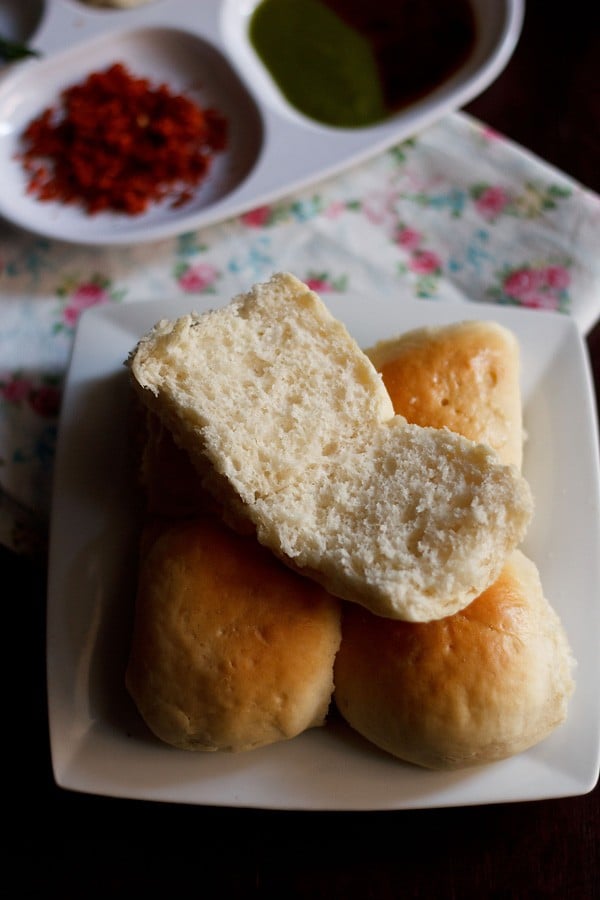
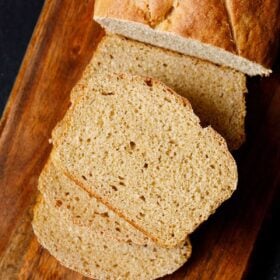
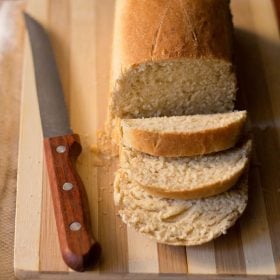
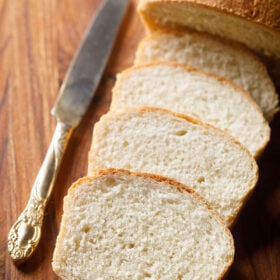
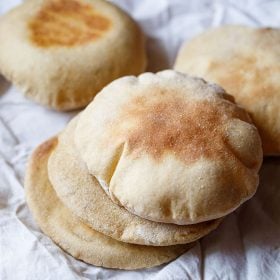
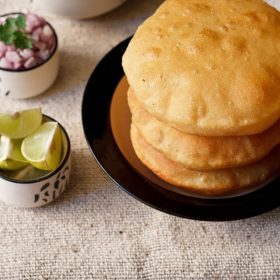
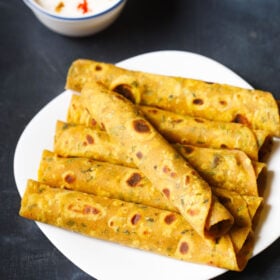
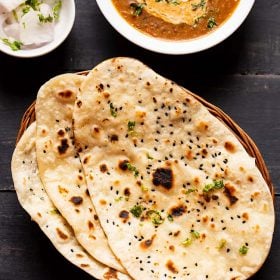
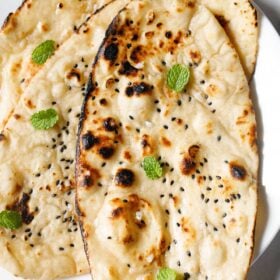








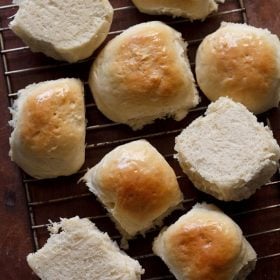
my Pav turn out excellent,thanks a lot. Pls share multigrain bread recipes.
thats great asha. i will share multigrain bread recipe.
I tried this recipe today, the pavs came up very well, but not that soft. I want to ask, should I bake with both top and bottom rods on or only the bottom rods
softeness depends on the yeast proofing as well as the kneading of dough. keep both the top and bottom heating rods on.
Hello! I am not clear on when to add the one cup milk. Please help.
pri, in this recipe we are not adding milk. we are just brushing pav with milk.
Hi, I attempted making these pavs..never done any baking in my life before..i used freash yeast ..till the time I popped them in the oven, I was so excited..perfect rising and the balls too became huge on the tray..God knows what went wrong after that..The oven was well preheated at 200, popped in the tray, the pav refused to turn golden for around 30 mts..so I decided to leave for some more time, finally removed after another 10 mins..the inside is very very soft, but the top is soooooo hard, It’s become like the French bread !!!! Please advise…
which oven you used, meaning microwave or an OTG and which rack you kept the pav. top is hard as its got over baked and hence become too crusty. also could be due to high temperatures in the oven.
Hi Dassana! i gv it a try again turned out excellent… thks! Request for jalebis pls…
thanks mohini. glad to know this. i have noted down the recipe request.
Hi thanks for awesome recipes. I have never baked in my life. It will be my first attempt. Instead of yeast and all of that can I use self raising flour. I wanna havePav bhaji today and we don’t get good ladi pav here 🙁
Thank you in advance
Cheers
Shraddha
thanks shraddha. for a good loaf or bread, yeast is recommended. there are recipes which do not use yeast, but i have never tried them. so cannot say if this recipe will work with self raising flour. i would suggest you to buy some good quality yeast to make pav or bread at home.
Lovely reciepe…just made it now…. I used 50:50 whole wheat : all purpose flour
thanks bernice. good to know this.
Thks Dassana, may be u are right will gv it a try once more.
welcome mohini
Hey dassana tried this pav today but it did’nt came out very well…it was very dense n top was hard too…i followed ur steps very carefully but i don’t know where i went wrong….plz advice dear…..
whenever bread becomes dense, then one of the main reason is always yeast. either the yeast is not of a good quality or the yeast is not in its shelf life or the yeast proofing did not happen correctly. so it can be any one of these reasons.
Hi Dassana tryd this pav today since ws mkg pav bhaji, but i dont knw why the pav didnt brown on top it was white on top, inside was soft, even base got baked properly(overall ws bit hard compared to other bread recipes,had baked this pav for 15min). followed recipe but dont knw where i went wrong. just one thing i noticed that after dough had leavened i punched and md equal balls and placed in greased tray but it had not leavened after 30min so i had kept it for more thn a hour to leaven. all other recipes like white bread, half and half bread and wheat bread top browned well. Thks!
welcome mohini. you could have baked for some more time to get the brown top. another reason could be it took a lot of time for second rise. some issue with the kneading of the dough. these are very soft pavs.
Hi Dassana..tried this receipe today came out well.but I have an issue seems like same for baking.i cook in convection microwave .but whenever I do baking my top of bread or cake gets brown n even hard .its not whn I cook for longer time also when it’s just 15 20 min.i tried putting aluminium foil but no effect ..what can be the reason. N if I took bread early its undone..kindly suggest
hi avita, in convection baking the heating is from the top. as a result the top of breads or cakes get browned faster. i used to experience this in my microwave oven. so when baking in a microwave reduce the temperature to -10 to -20 degrees for any recipe that has been baked in a regular oven or OTG. also cover after 10 minutes. when baking bread and cakes both, i used to cover the tops with aluminium foil after 10 to 15 minutes of baking.
Dassana the yeast i used for all my recipes is (brand angels) dry instant yeast, so am a bit confused with what kind of yeast it is (instant yeast, dry active yeast, it looks like kuskus). All this while i took the proportion of dry active yeast mentioned in recipes. Please guide me Dassana. Thks!
hi mohini, instant yeast need not be activated in warm water. they are added directly to the dough. whereas dry active yeast needs to be activated. fresh yeast is what is used in bakeries. fresh yeast also needs to be activated in warm water.
when switching dry active yeast for instant yeast, the amount becomes a bit more for dry active yeast. eg 1 tsp instant yeast = 1.5 tsp of active dry yeast. for small amount like 1 tsp it does not make much difference, but for more amounts of yeast, it better to convert and then add. you can use this conversion table while switching – http://www.traditionaloven.com/conversions_of_measures/yeast_converter.html
This differentiation is very helpful. You are a food-wiki!
Thanks Uday
hi,The recipe was good as well as pictorial demonstrations. My outer crust was hard as compared to inside of pav. Do I’ve to knead the dough for 5-7 minutes ( when the dough is risen and doubled) or do I’ve to reduce the baking time to 20 min. because in 20 min. my buns started to brown. And one more request could you please share the recipe of multigrain bread.
the pav got baked for a some more time. oven temperatures differ in various makes and models. so the timing will be different for each oven. you just have to knead the dough lightly after the second rise. just for a minute. yes please reduce the time to 20 minutes. the test is that when tapped, the pav buns should sound hollow. this means that they are done. also keep both the heating elements on if you are using OTG. and do not keep the pav tray/pan close to the top heating rod. then the crust will get too browned and hard.
thank you for the valueable advice .you advised me to keep both the heating elements on in the case of otg. I’m using 35l of Bajaj Majesty otg (newly bought) and I’m getting grill, warm, toast, bake, roti options in that otg .I’m doing breads and cakes on bake mode where only bottom heating rod is on. shall I use toast option.
if your oven refers to toast option as heating both the top and bottom heating elements on, then yes, use the toast option. in my oven i do not have so many options. just the bake and grill mode.
Can you double the recipe if you want to make more pav’s in the same ratio?
yes you can
Hi I don’t have oven at my home can I try this in cooker placing sand at bottom also I don’t have active yeast I just have dry yeast in powder can I use the same?? If yes then what would be the ratio??
abha, you can try making in pressure cooker. you can use ½ to ¾ tbsp dry active yeast.